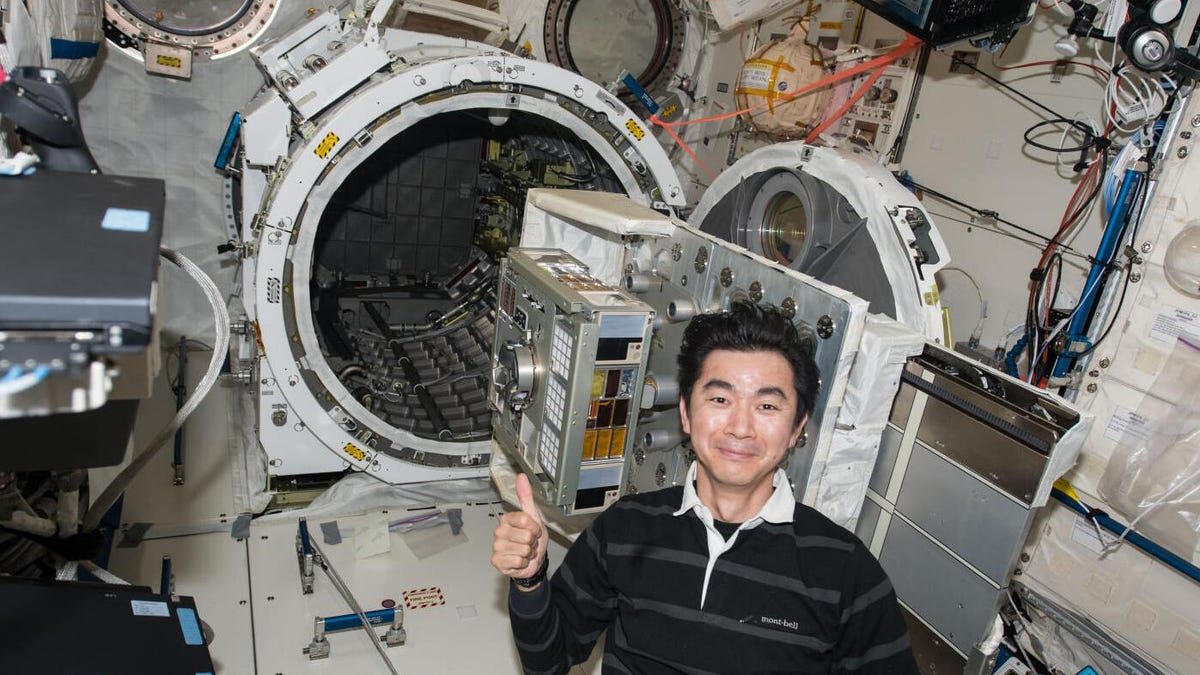Bacteria on the ISS survive the perils of space for three years
Three years in space wasn't enough to kill a hardy radiation-resistant bacterium, suggesting bacteria may be able to travel between planets.

Kimiya Yui helped set up the exposure experiment module on the International Space Station back in 2015.
Space is not kind to humans. Even inside the International Space Station, scientists have shown prolonged flight can lead to some negative health effects and mess with DNA. But if you're a microscopic organism, things can be a little different.
In fact, some fungi that have made a home on the ISS even find the conditions preferable -- they can feed on the extra radiation. This kind of evidence has led some scientists to suggest microscopic organisms might be ejected into space and perhaps they could move between planets, seeding life across the cosmos.
It's a controversial concept known as "panspermia," and it's been championed by some unusual characters in the past as an alternative theory for how life began.
In a new study, published in the journal Frontiers in Microbiology, Japanese researchers sent densely-packed balls of bacteria to the International Space Station and stuck them on the outside of the lab, where they were exposed to the harsh, cold and radiation-heavy vacuum of space.
The experiment, known as Tanpopo, has been running since 2015. In Japanese, tanpopo means dandelion, and the experiment is so named because the dandelion spreads its seeds via the wind. Could the same thing happen in space, with radiation-resistant bacteria? That was the question Akihiko Yamagishi, an astrobiologist at the Tokyo University of Pharmacy and Life Science, set out to answer all the way back in 2007, when his experiments were first accepted as a candidate experiment on the ISS.
Yamagishi doesn't see himself as a proponent of panspermia but wanted to see if there were ways microbes might be able to survive a trip from Earth to somewhere else in the cosmos.
When the Japanese space agency's Experiment Handrail Attachment Mechanism was installed on the ISS in 2015, Yamagishi and his team finally had a chance to conduct their research. By placing colonies of the radiation-resistant Deinococcus into wells and drying the suspensions in the air over and over again, they were able to create "pellets" of bacteria. In 2015, these pellets were installed on the space station in plates aboard the ExHAM.
Concurrent experiments were designed to look at the pellets after one, two and three years. The experiment officially concluded in 2018 and since then Yamagishi's team have been analyzing the data.
The major finding shows these pellets can survive damage from UV radiation in space a lot better when the pellets were thicker. When the pellets were around half a millimeter thick, the outer layers of bacteria began to break down, but those in the center survived. Yamagishi and his team reason these thicker pellets of bacteria, exposed to interplanetary space, might survive from two to eight years -- in theory, long enough to be ejected from Earth and make it to one of our closest neighbours.
"The results suggest radioresistant Deinococcus could survive during the travel from Earth to Mars and vice versa, which is several months or years in the shortest orbit," said Yamagishi.
Bacterial astronauts
Panspermia proponents suggest some bacteria may be able to take interplanetary trips trapped inside meteorites and micrometeorites, a theory known as lithopanspermia. Yamagishi's work took a look at a different theory -- that these ball-like colonies of bacteria might protect themselves. This is known as massapanspermia.
But there are a number of lingering issues. A straight shot from Earth to Mars isn't exactly the most likely route microbial adventurers might take.
"In theory the time could be months or years, if you hitched a ride aboard the Mars Perseverance rocket," says Brendan Burns, an astrobiologist at the University of New South Wales not affiliated with the study. "But in terms of 'natural' journeys the likelihood of an object ejected from Earth and hitting Mars in a short space of time is slim."
While Yamagishi's research does demonstrate the ability for bacteria to survive space for extended periods of time, Burns notes meteorites can have a flight time of more than 10 million years before they jump planets.
And there's a pretty big problem to overcome if you're microscopic and trying to relocate from planet to planet. First, you have to be ejected from your home planet without dying, survive the long (really long) journey across space and then make it through an atmospheric re-entry. Even NASA robots are terrified of entering the atmosphere of Mars.
Yamagishi concurs. "Very little is known about entry and ejection," he says.
But let's say Deinococcus got through all of that, what happens when the bacteria get to their new home? The situation is likely dire for an Earth transplant, used to a world of running water and protected by a thick atmosphere.
"Even if a given lifeform could survive interplanetary travel, the conditions of where it ends up must be just right for it to take off again," says Burns. He notes the microbes would need to look for nutrients and would need to be hardy enough to withstand any differences in the atmosphere. So while the panspermia hypothesis remains possible, Burns says, "the jury is still very much out."
Yamagishi's team and the Tanpopo mission will continue exposure experiments "with different species in different conditions" and hope to see how general the process of massapanspermia may be.

